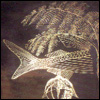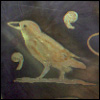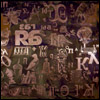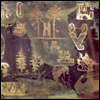Afrika (Sergei Bugaev) (Online Gallery)
GALLERY | BIO | INTRODUCTION | SOLO EXHIBITIONS | SOLO AND DUO EXHIBITIONS | GROUP EXHIBITIONS | PROJECTS
Introduction by Oleysa Turkina and Victor Mazin; translated by A D Haun.
ARTMargins thanks I-20 gallery (NYC) for their support of this presentation.
Born in 1966, Novorossiysk (Black Sea)
Lives and works in Saint Petersburg, Miami and New York.
http://en.wikipedia.org/wiki/Afrika_%28Sergei_Bugaev%29
In the beginning was the rebus. The rebus spoke by means of things. The rebus presupposed translation from the language of words to the language of things. The rebus presupposed translation from the language of things to the language of words.
However, there are moments in history when translation is impossible–when things cannot be formed into words, when words lose their components, or when words turn into things. Such an event takes place when a rebus is formed by an insane cryptographer.The rebus ceases to be a rebus. The rebus turns into an unsolvable puzzle.
Such an event also takes place when the rebus presents itself to the gaze of an outsider.
Letters and scraps of words take on the status of things. Speech reifies itself. The word becomes an image. The word itself and the letters become the same as esthetic images, enjoying the same rights as the representations of, say, a mushroom, an ABC primer, or a gallows. If the image speaks, then this speech is metaphorical. The image shouts and remains mute. A conversation by means of images (that is, a conversation by means of fragments of words, letters, and things) reminds us of the fact that we live in an age of total visualization, in an epoch of thought dominated by the right hemisphere of the brain, in an epoch when the screening of a novel displaces the novel itself.
Using the example of the appearance of images on copper plates designated “rebuses,” it is possible to trace a certain evolution in the artist’s activities and in the sphere of esthetic images and in the sphere of the visual as a whole.
The first rebuses were created by Sergei Bugaev (Afrika) as Soviet rebuses of the 1950s, reappropriated and displaced onto different material.
Three types of works were generated. First, independent elements started to insinuate themselves into the reappropriated rebuses, the elements distorting the message (Rebus #1,9). The longer the work went on, the more and more such elements appeared. In the final analysis, the changes and distortions of the “original” made it impossible to read the rebus, to translate the graphic syntax into the symbolic register of definite language
On the other hand, the esthetic process of adding to the burden continued because of the images on the copper surface. The logical key to reading was lost, and the rebus turned into an unsolvable puzzle. Moreover, whereas earlier all elements were familiar to the Russian audience, subsequently rebuses appeared which were created initially on an “alien” American basis.
Other rebuses appeared, absent the images, with a smooth mirror-like surface reflecting light and playing with the patterns of geometric forms, depending on the angle at which the light fell (installation views).
A third category of rebuses appeared with displaced pictures on the copper surface: including an engraving by Durer and the figure of the crucified Christ crowned by the head of Lenin.
All three types of rebuses came to bear less and less resemblance to rebuses and more and more resemblance to puzzles assuming a multitude of interpretations.
Thus, a general tendency is evident in this evolution: Rebuses changed from works read symbolically–even if read in fragments-to the puzzle which appeals to the onlooker with its affective “field,” its space of the imagined. The puzzle takes on the status of an esthetic object; in its resistance to being read literally, it is freed from its serviceable function, affording the pleasure of solution.
The observed shift from the symbolic to the imagined reflects the moment in the evolution of a man when, in his eyes, a general shift from the symbolic to the imagined takes place–or in the case of a novel, when there is a shift from the text-story to the actualization and activation of the video story. From the viewpoint of psychogenesis, the shift can be seen as regression, as its own kind of adaptive reaction to the distorting of territory –the change on earth in the global sense by way of telepresence, by way of high-speed airplane flight, by way of virtual reality’s entering into life; and in the local sense, by way of the disintegration of the Soviet identity. In addition, this shift is an evolution toward the fulfillment of various unconscious desires and fantasies. What s more, this shift is an adaptive reaction to the reconstruction of a common language. And, finally, this shift is the adaptive reaction to a drastic change in the surrounding visual space. The artist directs his gaze toward the primary image, to the imaginary, to the regressive puzzles. The regressive puzzles are a series of partial objects-or images-not gathered into an integral single image.
The combination of images, things, and remainders of letters, words, and phrases on one surface demonstrates the overburdening of the sphere of visual images in its entirety (Regressive Puzzle, STF9, Rebus #26). It demonstrates the schizophrenia of the surrounding space. In other words, it is not only a question of representation, but a criticism of it. A critique of representation is connected to the mechanism of segregation. A definite representation imposes upon us a certain world view, rejecting the rest of those that might be possible. These are laws by which we live, even if we are not aware of them. Fragments of these laws break through in the regressive puzzles on the surface, emerging from the innermost depths of the unconscious. The letters “l”, “v”, “o” seep through, first words such as mama, scraps of phrases such as mazafaka.
These works are united not only by the technique involved-that is, various layers of staining with acid on the copper-coated plates. They are connected not only by the regressively enigmatic images, the remainders of words and things, but also by the dynamic of reflecting the surrounding world with its multiple languages, multiple fragments of knowledge, multiple torrents of information, and the absence of a unified picture of the world. It is possible to regard the regressive puzzles as a multi-layered cake – or “palimpsest.” The word palimpsest is appropriate here, not only in connection with the semantic multiple meanings, but also in connection with the fact that under one surface another is hidden; on one surface, one or two or three are accumulated.
In this metaphoric-metonymic layering, the spectator finds not visual cliches, but separate images that affect him personally. These images, together with the remains of words, are reminiscent of that moment of personal and general history when speech appeared, when sounds were transformed into messages separated from things, when speech became the most important socializing element in the human community. Regression to this situation of the origin of speech and thought turns into progress of an esthetic kind.
From the orderly visual cliches of advertising, television, and architecture, the artist inclines toward the spree of the phantasmic. The phantasmic sphere is connected to the sensory sphere – to which W. Ben jamin dreamed of returning man in his critique of mass culture.
Evidently art also gives us the chance to return to our own feelings. Under the influence of mass hypnosis through the hyper-stimulating mechanisms of a surfeit of visual, auditory, and conceptual input, what the artist calls “semiotic freezing” or a “semiotic hunger strike” takes place. This freezing of the discursive space puts into operation the visual esthetic as anesthetic.
The artist undertakes efforts to defrost, to start up a certain centrifugal force-drawing images or separate words from the history of art, politics, different languages, profanity, the iconic representation of God’s eye, icons; and places all on the mirror-like copper plane. All of this rapidly scatters in every direction from the place where the artist had hidden himself.
The unsealing of the larger sphere through a certain selection and reification of letters, words, and images appeals to a special type of memory, which is eidetic memory. It should be remembered that eidetic memory is this capacity to retain exclusively clear and bright images of objects seen. Eidectic memory becomes vitally important at moments when coherent grammatical structures are disturbed.
Eidetic memory is characteristic of mnemonists, people who remember everything. A.R. Luria described such a one when he referred to the “absolute” memory of Mnemonist Sh. He had an eidetic memory that reified not just semantic units, but also separate sound combinations. Mnemonist Sh. formed from these distinctive “rebuses” ways of “recollection,” which invariably led him to his childhood home. Another instance, also described by Luria, involved a man who had lost his memory as the result of a serious wound. Z’s sense of grammatical connections, the logical consistencies, was disrupted, but at the same time his vivid childhood memories were exclusively preserved. This man could not compose letters into words, or words into sentences. In order to remember, for example, the letter “sh,” he had to remember the name of his sister (Shura). After he had lost his memory, he spent all his time solving puzzles in which his own image rose up after each sound combination. In that way both the loss of memory and absolute memory deprived him of the opportunity to make use of a grown man’s discourse. Thus did Mnemonist Sh. and the patient Z. return, each in his own way, to regressive puzzles.
Puzzles appear before the onlooker, allowing him to regress to childhood instruction, to play games with blocks. The word cannot be reduced to the thing. Being overburdened with images delays perception. What is depicted here? Where are these images from? They return to you in dreams.
1999
Russia Pavilion, XLVIII Biennale di Venezia, Venice, Italy (catalogue).
Sergei Bugaev Afrika, 1-20 Gallery, New York.
Sergei Bugaev Afrika, Galerie Vedovi, Brussels, Belgium.
Sergei Bugaev Afrika. No Name Gallery, Rotterdam, The Netherlands.
1998
Sergei Bugaev Afrika: New Photographs. New academy, St. Petersburg, Russia.
1997
Sergei Bugaev (Afrika). Rebus 11: Works on Copper. 1-20 Gallery, New York (catalogue).
1996
Evolution of an Image: Light, Sound and Material. (with Tommi Groniund and Peteri Nisunen, Finland). State Russian Museum, St. Petersburg. Curated by Olessia Turkina. (catalogue).
Afrika. Peter Schuengel ACP Gallery, Salzburg, Austria.
Doctor and Patient: Memory and Amnesia. (With Bracha Lichtenberg-Ettinger, France). Pori Art Museum, Pori, Finland. (catalogue).
1995
Sergei Bugaev Afrika. Krimania: Monuments, Icons, MazAfrica. MAK-Austrian Museum of Applied Arts, Vienna, Austria. Curated by Peter Noever. (catalogue).
1994
Africa. I’Espace Montjoie, La Plaine St. Denis, Paris, France.
1993
Method (one-room installation). The Pori Art Museum, Pori, Finland. (catalogue).
1992
Afrika. Fisher Gallery, University of Southern California, Los Angeles. Travelled to Queens Museum of Art, New York; Montgomery Museum of Fine Arts, Montgomery, Alabama; the Wolfsonian and New World Galleries, Miami-Dade Community College; and the Wexner Center for the Arts, Columbus, Ohio. Curated by Louis Grachos. (catalogue).
1991
Donaldestruction. Southern Exposure at Project Artaud, San Francisco. Travelled to Institute for Contemporary Art (ICA), the Clocktower Gallery, New York (curated by Rebecca Quaytman); the Power Plant: Contemporary Art at Harbourfront, Toronto; and CRDC, I’Espace Graslin, Nantes, France. (catalogue).
1990
Donaldestruction. The Lenin Museum, Leningrad.
1989
Africa and Timur Novikov. The Raab Gallery, London.
1986
Afrika. Gallery “ASSA,” Leningrad.
1982-1985
Apt-Art Exhibitions. Studio of Timur Novikov, Leningrad.
1998
It’s the Real Thing: Soviet and Russian Sots Art, Frederick R. Weisman Art Museum at the University of Minnesota, Minneapolis, MN (catalogue).
1997
Kabinet, Stedelijk Museum, Amsterdam. Curated by Rudi Fuchs and Guert Imanse. (catalogue).
State of the Art. Art Restoration for Cultural Heritage (ARCH), and the Guggenheim Museum, New York. Organized by Francesca von Habsburg. (web site).
St Petersburg Festival, World Financial Center, New York.
Red, State Russian Museum, St. Petersburg.
1996
Strangers in the Arctic: ‘Ultima Thule’ and Modernity. Rundetarn, Copenhagen. Travelled to Pori Art Museum, Pori, Finland; Museum of Contemporary Art, Helsinki, Finland; and the Art Gallery of Ontario, Canada (catalogue).
Metaphem des Entrucktsteins: Aktuelle Kunst aus St Petersburg. Badischer Kunstverein, Karlsurhe, Germany. (catalogue).
Self-Identification: St Petersburg Art, 1970s-1990s, the Sophienholm, Copenhagen, Denmark. (catalogue).
1996
Benefit Exhibition, New Museum of Contemporary Art, New York.
1995
Layers: Contemporary Collage from St Petersburg, Russia. Fine Arts Gallery, University of Maryland, Baltimore County, Maryland. Curated by Alla Efimova. (catalogue).
From Gulag to Glasnost Nonconformist Art from the Soviet Union: The Norton and Nancy Dodge Collection, The Jane Voorhees Art Museum, Rutgers, State University of New Jersey, Rutgers, New Jersey. (catalogue).
Self-Identification: St Petersburg Art, 1970s-1990s. Kiel City Art Gallery, Kiel, Germany. Travelled to Haus am Waldsee, Berlin, Germany; State
Russian Museum, St. Petersburg. (catalogue).
1994-1995
Cocido y Crudo. Centro National Cultural Reina Sofia, Madrid, Spain. Curated by Dan Cameron. (catalogue).
1994
New Russian Art: Paintings from the Christian Keesee Collection, Oklahoma City Art Museum. Oklahoma City. (catalogue).
Renaissance and Resistence. The Marble Palace, State Russian Museum, St. Petersburg.
The Third World War. The Stroganoff Palace, St. Petersburg.
1993
Drawing the Line Against AlDS: 41st Venice Biennale. The Peggy Guggenheim Collection, Venice, Italy. Travelled to Guggenheim Musuem in Soho, New York. (catalogue).
After Perestroika: Kitchenmaids or Stateswomen. Centre d’Art Contemporain, Montreal. Travelled to Picker Art Gallery, Colgate University, Hamilton,, New York; through 1994 at DePress Art Center and Gallery, Hope College, Holland, Michigan; Westem Gallery, Western Washington University, Bellingham, Washington; the Iris and B. Gerald Cantor Art Gallery, College of the Holy Cross, Worcester, Massachusetts; through 1995 at the Art Museum, Cranbrook Academy of Art, Bloomfield Hills, Michigan; the Art Gallery of Mount Saint Vincent’s University, Halifax, Nova Scotia, Canada; through 1996 at the Atlanta College of Art Gallery, Atlanta, Gorgia. Curated by Margarita Tupitsyn. Organized by Independent Curators, Incorporated (ICI). (catalogue).
Method. the Pori Art Museum, Pori, Finland. (catalogue).
The Aesthetic Arsenal: Socialist Realism under Stalin. Institute of Contemporary Art (ICA), PSI Museum, New York. Curated by Alana Heiss. (catalogue).
The Exquisite Cadaver. The Drawing Center, New York.
From Chaos to Creation: Soviet and Russian Art, 1972-1992. The Rye Arts Center, Rye, New York. (catalogue).
St. Petersburg Alter. Le Manoir del la Ville de Martigny, Martigny, Switzlerland. (catalogue).
1992
Art Meets Ads, Dusseldorf Kunsthalle: 25th Anniversary Exhibition, Dusseldorf, Germany. Curated by Jurgen Harten and Michael Schirner. (catalogue).
1991
Binationale: Soviet Art Around.
1990
Dusseldorf Kunsthalle, Dusseldorf, Germany. Curated by Jurgen Harten. Travelled to the Israel Museum, Jerusalem; through 1992 at the Central House of Artists, Moscow. (catalogue).
The Problem of the Individual Body in the Era of Late Totalitarianism: Recent Art of Leningrad. Museo de Arte Moderno, Mexico City, Mexico. Curated by Teresa del Conde and Alla Mitrofanova. (catalogue).
The Coldness and the Beauty: New Art from Leningrad. The Helsinki Festival, Gallery Vapauden Aukio (Square of Liberty), Helsinki, Finland. (catalogue).
Soviet Contemporary Art: From Thaw to Perestroika. Setagaya Art Museum, Tokyo, Japan. Curated by Junichi Shioda. (catalogue).
Geopolitic. State Museum of Ethnography of the Soviet People, Leningrad.
Exhibition of Neo-Academism. The Lenin Museum, Leningrad.
New Generation, State Art Museum of Kramskogo, Voronich, USSR.
1990
Between Spring and Summer: Soviet Conceptual Art in the Era of Late Communism. Tacoma Art Museum, Tacoma, Washington. Travelled to the Institute for Contemporary Art (ICA), Boston; and through 1991 at the Des Moines Art Center, Des Moines, lowa. Curated by David Ross and Elisabeth Sussman. (catalogue).
In the Soviet Union and Beyond. The Stedelijk Museum, Amsterdam, The Netherlands. Curated by Wim Beeran. (catalogue).
Le Tenitoire de l’Art, Institute des Hautes Etudes en Arts Plastiques, Paris. Travelled to State Russian Museum, Leningrad. (catalogue).
The Friends of Mayakovsky Club: Exhibition ll, Paul Judelson Arts, New York.
The Work of Art in the Age of Perestroika. Phyllis Kind Gallery, New York. Curated by Margarita Tupitsyn. (catalogue).
1989
The Green Show, Exit Art, New York. Travelled to the Dunlop Gallery, Regina Public Library, Saskatchewan, Canada; and the Mendel Art Gallery, Saskatoon, Canada. (catalogue).
The First North American Exhibition of the Friends of Mayakovsky Club. Paul Judelson Arts, New York.
Selected Works from the Frederick R. Weisman Art Foundation. Wright Art Gallery, University of California, Los Angeles. (catalogue).
Red Wave. West Sawtelle Gallery, Los Angeles.
From Unofficial Art to Perestroika. Exhibition Pavillion on the Harbour, Leningrad.
Soviet Art from Leningrad. The Bluecoat Gallery, Liverpool, UK.
Budka: Exhibition of Leningrad and Finland Artists, Grafiart Gallery, Turku, Finland.
Four Artists from Leningrad, Kaj Forsblom Gallery, Helsinki, Finland.
1988
The New Ones from Leningrad. The Kulterhuset, Stockholm. (catalogue).
80 Talents of the Russian Avant-Garde. Art Atrium, Stockholm.
Forty Years of Leningrad Non-Official Art Exhibition Hall on the Harbour, Leningrad.
The New Artists. The Culture House, Aarhus, Denmark.
Da Da Mayakovsky. Dionysius Gallery, Rotterdam, The Netheriands.
The Leningrad Show: 21 Artists from the Fellowship of Experimental Art. Memorial Union Art Gallery, University of Califomia, Davis.
7 Independent Artists from Leningrad. Young Unknowns Gallery, London.
The Friendship of Independent Art. The Palace of Youth, Leningrad.
Exhibition in Honour of the 95th Birthday of Mayakovsky. Club NCNC, Leningrad.
New Paintings, 80 Artists. From the “ASSA” program, Meiz House of Culture, Moscow.
1987
Exhibition of the New Artists on the Premiere of the Film “ASSA.” Palace of Youth, Leningrad.
Exhibition of the New Artists: Dedicated to the Closure of the Gallery “ASSA” Leningrad.
New Year Exhibition. House of Culture of Workers of Art, Leningrad.
Exhibition of the New Artists. United Museum of Creative Community, Leningrad.
Exhibition of “Bez Oreoloa.” Gdansk Kantor Sztuki, Gdansk, Poland.
The Friendship of Independent Art. Palace of Youth, Leningrad.
Forum “Tvorcesko Molodezi Leningrad and the New Artists in the Program of the Forum. Palace of Youth, Leningrad.
Art Connection. The ‘New Artists’ in the ‘Days of Art’ Festival Riga, Latvia.
The Friendship of Independent Art. Exhibition Pavillion in the Harbour, Leningrad.
Exhibition of the “New Artists” on the First Celebration of the City. Peter and Paul Fortress, Leningrad.
Exhibition of the New Artists in the Program of the 17th Youth Exhibition. The House of Artists, Kuzneckij Bridge, Moscow 1986.
1986
Autumn Exhibition of the Friendship of Independent Art. Palace of Youth, Leningrad.
New Forms: The New Artists. Vodocanal Club, Leningrad.
Society of Experimental Art Exhibitions. The Palace of Youth, Kirov Palace of Culture, Leningrad.
1985
Fourth and Fifth Exhibitions of the New Artists. Gallery “ASSA,” Leningrad.
Happy New Year Exhibition of the New Artists. The New Theatre, Leningrad.
Society of Experimental Art Exhibitions. The Palace of Youth, Kirov Palace of Culture, Leningrad.
1984
Third Exhibition of the New Artists. Gallery “ASSA,” Leningrad.
Society of Experimental Art Exhibitions. The Palace of Youth, Kirov Palace of Culture, Leningrad.
1983
Second Exhibition of the New Artists. Gallery “ASSA,” Leningrad.
1982
The New Artists. Gallery “ASSA.” Leningrad, USSR.
1997
Three Piglets. Started the weekly radio program in St. Petersburg.
Yablanka (Apple). Worked as an advisor to a parliament member of this liberal political party, Russian State Parliament, Moscow.
1996
Short Stories Around Russia. Created this program for Vzjliyad (Look), Russian State Television, Russia.
1993
Kabinet. Co-founded and edited this biannual journal of science and arts, St. Petersburg. An English anthology published in 1997 by the Stedelijk Museum Amsterdam, in conjunction with the exhibition, Kabinet.
1990
August Pace. Set and Costume Designs. The Merce Cunningham Dance Company. Organized by John Cage and Merce Cunningham. Performances in 1990 and 1993 at the University of California, Berkeley; the City Center, New York; and the Paris Opera.
1980s-1995
Popular Mechanics. Performances with the Lenignrad-St. Petersburg experimental orchestra. Founded by Sergei Kuyokhin, director and composer.
1987
“ASSA.” Played the main role in the landmark Film from the new Russian cinema. Directed by Sergei Solovjev. Screened in 1996 Russian Film Festival at Lincoln Center, New York.
1984
Anna Karenina. Set and costume design. Performances by the New Theatre, Leningrad.










